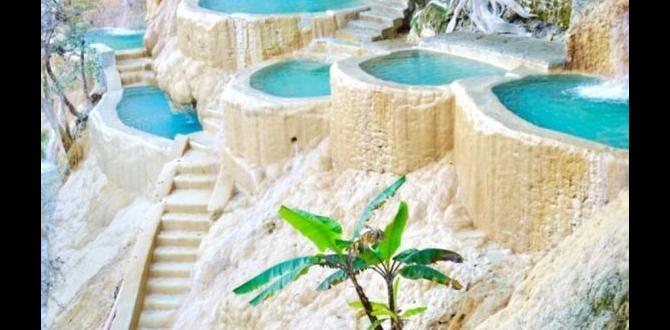Antigua Guatemala walkable routes and essential maps make exploring this colonial gem easy and stress-free. Discover the best paths to navigate its charming streets, historic sites, and vibrant markets with confidence.
Antigua, Guatemala, is a city that begs to be explored on foot. Its cobblestone streets, colorful buildings, and stunning volcanic backdrops are best savored at a leisurely pace. But even in a relatively compact city, knowing where you’re going can make all the difference between a delightful adventure and a frustrating wander.
Many travelers worry about getting lost or missing out on hidden gems. This guide is here to help you navigate Antigua with ease, providing you with the essential maps and walkable routes you need for a memorable and stress-free experience. We’ll break down the best areas to explore and how to connect them seamlessly. Get ready to discover Antigua’s magic, one step at a time!
Why Antigua Guatemala is Perfect for Walking
Antigua’s charm lies in its well-preserved colonial architecture, a layout designed for pedestrian exploration, and a relatively flat topography within the city center. The city’s historical core is a UNESCO World Heritage site, meaning its streets are relatively protected and designed for human scale. This creates an intimate atmosphere where you can truly soak in the history and culture.
Unlike many sprawling modern cities, Antigua’s main attractions are clustered together, making them easily accessible by foot. This not only saves you money on transportation but also allows for spontaneous discoveries down charming side streets and unexpected plazas.
You can wander past iconic landmarks like the Santa Catalina Arch, explore bustling local markets, and stumble upon serene convent ruins, all within a few blocks. The absence of heavy, fast-moving traffic in the central tourist zones further enhances the walking experience. In essence, Antigua Guatemala is a walker’s paradise, offering a rich tapestry of sights, sounds, and flavors best experienced at a human stride.
Essential Tools for Your Antigua Walks
Before you set out, having the right tools will make your explorations smoother and more enjoyable. While Antigua is walkable, a little preparation goes a long way. Here are some essentials to consider:
- A Reliable Map: This is your most crucial companion. While your phone can be a lifesaver, a physical map or a downloaded offline map on your phone is invaluable, especially in areas with spotty Wi-Fi.
- Comfortable Walking Shoes: Cobblestone streets can be beautiful but uneven. Prioritize comfort and good grip. Your feet will thank you after a day of exploring.
- A Reusable Water Bottle: Staying hydrated is key, especially in Guatemala’s often warm climate. You can refill your bottle at many hotels and restaurants.
- Sun Protection: A hat, sunglasses, and sunscreen are a must. The sun at higher altitudes can be intense, even on cloudy days.
- A Small Backpack or Crossbody Bag: To carry your essentials, snacks, and any souvenirs you pick up along the way.
- A Portable Charger: For keeping your phone or GPS device powered up throughout the day.
Understanding Antigua’s Layout: A Grid System
Antigua’s historic center follows a logical grid system, which makes navigation surprisingly easy once you understand it. The city is divided by two main avenues:
Calle Ancha de los Reyes / 5a Avenida Norte and Calle Ancha de las Nazarenas / 6a Avenida Norte (running north-south).
Calle de la Merced / 1a Calle Oriente and Calle del Arco / 3a Calle Poniente (running east-west).
The streets are numbered, generally increasing as you move away from a central point. However, there’s a slight quirk:
North-South Streets: Numbered streets (1a Calle, 2a Calle, etc.) generally run east-west, and numbered avenues (1a Avenida, 2a Avenida, etc.) generally run north-south.
East-West Streets: While the north-south avenues are fairly straightforward, the east-west streets have both names and numbers. The numbers often refer to their distance from the central park. The odd-numbered streets are often referred to as “Calles” (streets), and the even-numbered streets are referred to as “Avenidas” (avenues), though this can be confusing as the north-south ones are always Avenidas by convention.
North vs. South & East vs. West: An easy way to orient yourself is to remember that the central Plaza Mayor (Parque Central) is the heart of the city. Streets north of the plaza are often prefixed with “Norte” (North), and streets south are “Sur” (South). Similarly, streets east are “Oriente” and west are “Poniente.”
Essential Antigua Guatemala Maps and Navigation Apps
Navigating Antigua is a breeze with the right map tools. Here’s a breakdown of your best options:
1. Google Maps (Offline Mode)
Google Maps is an indispensable tool for modern travelers. It offers detailed street views, business information, and real-time navigation.
Why it’s great: It’s familiar, covers most businesses and attractions, and allows for offline use.
How to use it effectively:
- Locate Antigua, Guatemala within the app.
- Tap on the search bar and type “Antigua, Guatemala.”
- Under the search bar, you should see an option to “Download” map area for offline use. Tap this and select the specific area of the city you want to download. Make sure to download a generous portion of the central area.
- Once downloaded, you can navigate using GPS even without an internet connection. This is crucial as Wi-Fi can be unreliable in some parts of the city, and local data can be costly.
Google Maps is particularly useful for finding specific businesses, restaurants, and hotels. You can also view user-submitted photos to get a feel for places before you go. For a more comprehensive understanding of the area, consider the National Geographic map of Antigua, which often highlights key landmarks and geographical features.
2. Physical Maps
Don’t underestimate the power of a good old-fashioned paper map. They don’t require batteries and are invaluable for a quick overview of the city’s layout.
Where to find them:
- Many hotels and hostels offer free tourist maps.
- Visit local bookshops or tourist information booths.
These maps are often curated with tourist interests in mind, marking major attractions, popular restaurants, and important landmarks. They are perfect for plotting out your day’s adventure before you leave your accommodation.
3. Specialized Travel Apps
Some apps are designed specifically for travelers and offer features tailored to exploring new cities on foot.
Examples include:
- Maps.Me: An excellent offline mapping app that is often more detailed than Google Maps for certain regions and allows crowdsourced contributions.
- Citymapper: While more known for public transport, it can be useful for walking directions and estimating journey times.
Download your chosen offline maps before you arrive in Antigua. This ensures you have navigation capabilities regardless of your connectivity.
Must-Visit Walkable Routes in Antigua Guatemala
Antigua is a city best experienced by setting out with a general direction and letting your curiosity guide you. However, having a few suggested routes can help you make the most of your time and ensure you don’t miss the highlights. These routes are designed for beginners and can be easily customized.
Route 1: The Classic Colonial Core (Approx. 2-3 hours)
This is the quintessential Antigua walking tour, hitting the most iconic landmarks. It’s perfect for your first day or if you have limited time.
- Start at Parque Central (Central Park): This is Antigua’s vibrant heart. Admire the Fuente de las Sirenas (Mermaid Fountain) and the surrounding colonial buildings.
- Visit the Cathedral of Santiago: Located on the east side of the park.
- Walk East to the Santa Catalina Arch (Arco de Santa Catalina): A short walk east from the park will bring you to this iconic landmark. Take some photos and soak in the atmosphere.
- Explore 4a Calle Oriente Southward: This street is lined with shops, cafes, and restaurants.
- Visit the Iglesia y Convento de La Merced: Head north from the Arch on 5a Avenida Norte to discover this stunning baroque church and its adjacent convent ruins, known for its beautiful yellow facade.
- Continue North to Iglesia de San Francisco: A further walk north will lead you to the well-preserved San Francisco Church and Museum.
- Head West towards La Azotea Cultural Center (Optional Extension): If you have more time and energy, you can continue west and slightly north towards La Azotea, which offers coffee tours and views.
- Return to Parque Central via 4a Calle Poniente: This street, also known as Calle del Arco, is another main thoroughfare with plenty to see.
Route 2: The Artisan & Ruin Explorer (Approx. 3-4 hours)
This route takes you to some of Antigua’s most atmospheric ruins and artisan workshops.
- Start at Parque Central.
- Walk West to the ruins of the Cathedral of San José El Viejo: These impressive ruins are just west of the park and offer a glimpse into Antigua’s past.
- Continue West to the Convento de Capuchinas: About a 10-15 minute walk west from San José. This is one of Antigua’s most extensive and fascinating ruin complexes, with a unique circular bell tower.
- Explore the surrounding artisan workshops: The area around Capuchinas is known for its jade workshops and other handicrafts.
- Visit the ruins of Iglesia del Carmen: Head back east and slightly south to find these picturesque ruins, often used for events.
- Discover the ChocoMuseo: A fun stop to learn about chocolate production, with workshops and a shop.
- Wander towards the Mercado de Artesanías (Handicraft Market): Located near Calle 3a Sur, this is a great place to browse textiles, wood carvings, and other local crafts.
- End your walk back in the vicinity of Parque Central or enjoy dinner in the La Union area.
Route 3: The Panoramic Views & Local Flavors (Approx. 3-4 hours)
This route is for those who want to experience Antigua from a different perspective and taste its local culinary scene.
- Start at the Santa Catalina Arch.
- Walk North on 5a Avenida Norte towards the Cerro de la Cruz (Hill of the Cross): This is a slightly steeper walk, take your time. The path begins a few blocks north of the La Merced church.
- Enjoy the Panoramic Views: From Cerro de la Cruz, you’ll get breathtaking panoramic views of Antigua, framed by the Agua Volcano. This is a popular spot for sunrise and sunset.
- Descend and head South to the Mercado Municipal (Municipal Market): Experience the bustling local market where you can find fresh produce, flowers, clothing, souvenirs, and delicious local food stalls for lunch.
- Explore the surrounding local neighborhoods: Venture into smaller streets around the market to see more of daily life in Antigua.
- Visit the Centro de Textiles Tradicionales de Guatemala (C NSUTFCTTG) or the Museo Textil: Learn about Guatemala’s rich textile heritage and traditional weaving techniques.
- Final stretch towards the Museo del Café (Coffee Museum) or a local café for a tasting experience.
Navigating Antigua’s Markets
Antigua’s markets are vibrant hubs of activity and excellent places to experience local culture. They are also easily accessible by walking.
Mercado Municipal (Main Market)
Located a few blocks south of the city center, this is where locals shop for everything from fresh produce and meats to household goods and clothing. It’s a sensory experience filled with colors, smells, and sounds. You can find very affordable local eats here, making it a great spot for lunch. Be prepared for a lively and sometimes crowded atmosphere.





